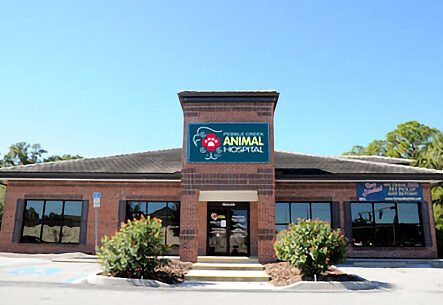Corn Snakes
What to Expect from Your Corn Snake
Corn snakes are good beginner snakes because they are non-venomous and are easy to handle and care for. They spend much of their time coiled up in containers and soaking in water. Corn snakes are most active at dawn, dusk and during the night. Most are calm, docile, placid snakes that thrive in captivity.
Vital Statistics
- Body length: 3-6 ft
- Body Weight: are and length dependent
- Life span: 10-20+ years (12-15 avg)
- Age of sexual maturity: 18-24 months
Is Your Corn Snake Male or Female?
Corn snakes are difficult to sex. Usually the males have thicker tails, and the anal spurs are more curved. A reptile veterinarian may use a probe to determine your snake’s gender.
Restraint
Minimal restraint is recommended as corn snakes are normally very docile. The body must be fully supported. Corn snakes will not wrap snugly around your arm, but they tend to pick a direction and go, so the head can be gently guided in another direction as necessary.
What Should You Feed Your Corn Snake?
In the wild, hatchlings feed largely on small lizards and tree frogs, while adults feed on small rodents and birds, killing their prey by constriction. In captivity, hatchlings can easily be started on pinkie mice (1-2 days old), quickly moving up the prey scale to fuzzies, crews and small adult mice. A live rodent should not be left unattended with any snake. Most corn snakes will take thawed frozen rodents, which is the preferred method over live prey. Juveniles should be fed every 5-7 days; adults every 7-10 days. As a general guideline, feed your snake after it has defecated. Adding nonsynthetic nutritional supplements such as HEALx Booster, to the prey’s diet may be beneficial. Corn snakes need water every day, but most people probably will not see the snake drink.
Enclosure
A corn snake should be housed in at least a 20-gallon tank with a secure top, as they are known to be escape artists. Aspen or cypress shavings are often used as substrate to allow the snake to burrow. Other suitable substrates are newspaper, reptile carpet or paper towels. Fresh water to drink must be provided in a reasonably sized bowl. They are solitary animals, so they are best housed alone in captivity.
Hiding places should be available, as corn snakes become stressed if they cannot hide. An interesting branch should be available for climbing and resting.
Temperature and Humidity
A temperature gradient from 70-80°F (21-29°C) should be maintained. The temperature can fall to the lower range at night. Heat may be provided by special reptile heating pads or incandescent light bulbs in reflector hoods and placed to avoid direct contact with the snake. One end of the enclosure should be maintained at a higher temperature for basking. Normal household humidity (30-50%) is usually fine for corn snakes, but it may need to be higher if your snake has trouble shedding.
Water
Corn snakes need a bowl of fresh water that is large enough for them to submerge their whole body in. Ensure that the bowl is not too deep for juvenile animals – approximately 1 inch (2.54 cm) of water. Because snakes often defecate in their water bowls, regular cleaning, disinfection and water changes must be scheduled at least weekly.
How to Keep Your Corn Snake Healthy, Happy and Safe!
- Buy from a reputable breeder because a young, captive-bred corn snake is less stressed and more willing to eat than a frightened, wild-caught snake.
- Take your new snake to a reptile veterinarian for a general health exam and parasite test.
- Leave a newly purchased snake alone in its enclosure for 1-2 weeks to acclimate to its new home.
- The water bowl should be changed whenever it is dirty, or at least once a week.
- Provide heat to your snake by special reptile heating pads or incandescent light bulbs in reflector hoods; the use of “hot rocks’ in the snake’s enclosure should be avoided.
- Interact with your corn snake during the evening hours when it is becoming active.
- Use a pillowcase as a transport container for short trips.
Housing for your corn snake should:
- Be a relatively large enclosure
- Have access to fresh water in a bowl that is large enough for the snake to soak
- Include suitable substrates that are easy to clean; newspaper, paper towels, reptile carpet, indoor-outdoor carpet, Astroturf
- Include branches for climbing
- Be escape proof
It is important for a corn snake to avoid:
- Live prey that may cause injuries
- Unsuitable substrates, such as cedar, corncob, wood chips/shavings, gravel, dirt or rocks
- “hot rocks”, which are considered a potential hazard
- Potentially toxic live plants
- Direct contact with heating elements
- Free roam of the house (to prevent trauma, ingestion of foreign materials and escape)
- Soiled water bowl
- Cats, dogs, other pets
- Unsupervised children
Most Common Disorders of Corn Snakes
- Dysecdysis (retained skin shed, retained eye spectacles)
- Respiratory infections
- Stomatitis
- Cloacal prolapsed
- Constipation
- Dystocia/retained eggs
- External parasites (mites and ticks)
- Intestinal parasites
- Cryptosporidiosis
- Bite wounds from prey
- Skin problems
- Inclusion body disease
- Spinal fractures/trauma
- Burns
- Loss of appetite
Regular visits with your exotic animal veterinarian should be scheduled to check for parasites and other early signs of disease and to promote a long, satisfying relationship with your snake. Contact us to schedule an exam with our reptile specialist, or regarding any questions.
Courtesy of Zoological Education Network
Tampa, FL 33615 (View map)
Tampa, FL 33647 (View map)
Tampa, FL 33617 (View map)
Tampa, FL 33647 (View map)








